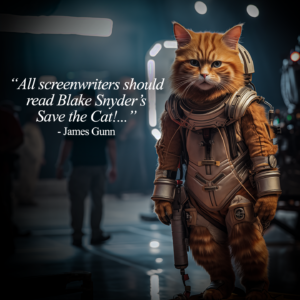In Save The Cat! I write about Basil Exposition, the character from Mike Meyers’s Austin Powers series played by Michael York. Basil is an inside joke, especially his last name, because every time he appears onscreen that’s all he does: Give the exposition. Basil tells Austin, and us, the history, state of, and future of the case that Meyers’ British superspy is trying to solve. And everyone, even Austin, rolls his eyes whenever Basil appears.
Imagine a whole movie peopled by no one but Basil Exposition!
Ron Howard’s The Da Vinci Code is a good, solid, entertaining movie. I don’t buy the backlash by critics who dub it a disaster. For fans of the book, the tale is enhanced by the visuals and settings. And Tom Hanks gives a truly weird performance that is definitely worthy of a look.
But!
Man, what an exposition headache!
While watching the film last night with friends (a packed house by the way), all I heard was characters talking the plot. And when they weren’t talking the plot, they were flashing back to scenes from history — and personal backstory — that gave me whiplash.
I advise screenwriters to try to avoid the flashback and the dream sequence and this movie will give me lots of headaches when writers say: “They did it in The Da Vinci Code!”
I am a big Akiva Goldsman fan, the screenwriter who adapted Dan Brown’s book, but I sensed the struggle. Every character was forced to talk. And talk. And talk. And all the talk — or 90% of it — had to do with events that were not occuring in the present. Only occasionally did drama get in the way of “facts.”
It made me realize why there was such controversy about Dan Brown adapting so much of his fictional work from the purely historical speculation found in books like Holy Blood, Holy Grail. Because of the nature of screenwriting versus a narrator telling a tale to us in a book, it reveals how much of Brown’s work is really just based on this outlandish conspiracy theory. Perhaps this story is not really a story at all but a documentary?
Also, try though they might to give Tom, as hero Robert Langdon, a “limp and an eyepatch” — that being his having a life-altering trauma as a child — there was no “arc” in Tom’s character. Yes, they hurtled across France and England finding clues and avoiding bad guys, but nothing happened. Not really. Or not enough to transform Tom’s character anyway.
And that is what a really good story is about.
After all, Basil Exposition is the same in the first Austin Powers movie as the last. When the only purpose of a character is to function as a plot teller, there really isn’t much room for more.
Blake Snyder
9 Comments
Leave a Reply Cancel reply
You must be logged in to post a comment.









Gosh, Blake. I’m going to have to disagree with you about DVC being “good, solid entertainment”. (I’m not even going to go into the silly theological premises of the book/movie.)
Well, okay, I’ll admit that if you don’t care that you don’t care, DVC works okay as a thriller: the Good Guy beats the Bad Guy, and finds what he’s looking for. But that’s about it.
(Spoilers included.)
Going by the title of your book, there is no STC moment at the beginning that tells us why we’re going to like Langdon. Or Sophie for that matter: her warning Langdon that he’s suspected of the murder doesn’t count since she does it completely without sympathy or concern. She’s prickly and hostile and… unappealing.
Watching some of the exposition scenes, I was wishing that Goldsman had read your comments about delivering such in “Pope in the Pool” moments, because I was deathly bored in them.
And I certainly didn’t have an idea of why things were important to either side of the conflict. Quite a lot of things were presupposed and assumed. For instance… what was the Bishop going to get out of it? “Keeping the secret” doesn’t cut it, when we don’t know the consequences of revealing the secret would be. It’s all “well and good” for people to say outside the story itself that revealing the secret would “bring down the Church”, but inside the story, they didn’t convince me. What are the stakes?
And for all the pseudo-intellectual blather, the characters are pretty stupid. I hadn’t finished reading the book by the time I saw the film. But watching the film, I certainly pegged “the heir” (which Teabing & Langdon consistantly refer to as “he”) as being Sophie. Was the nickname “Princess Sophie” too difficult for them to recognize? And I made that connection at least an hour before the story got there.
There were some other stupid things thrown into the plot that irritated the heck out of me. And that kills entertainment value for me. For instance: Langdon throws out a comment at Teabing’s place that Newton had been persecuted by the Church, apparently for his theory of gravity. Now, aside from the fact that that isn’t a fact, shortly thereafter, their quest takes them to the grave of Newton. And where is that? In Westminster Cathedral (Hello? “The Church”?), where there is a HUGE monument to him. If that’s persecution, can I have some? (And, by the way, the “Newton persecution” thing is something Goldsman added to the story.)
The hero doesn’t drive the action. The hero doesn’t seem to care that he’s accused of murder. What is really at stake is never really articulated in a way we can “buy” it. (The Fifth Element does a much better job at it.)
The production values are lovely. But I spent over 2 hours watching a film where there wasn’t really one single character I liked or cared about. That’s not entertaining.
I have not (yet) read the book or seen the movie, but I don’t mind “spoilers.”
It seems what both Blake Snyder and Sarah Beach are saying is that the novel itself is really an outline for a series of novels. It seems to have struck a number of readers the same way a novelist’s personal notes would strike a reader.
Now what if the entire story was broken up into a series of novels, with the first starting with the secret birth of the child.
Then the next novel developes the situation where it is decided that this secret must be kept so that “The Church” can be founded on a solid foundation with no questions that contradict the principles being promulgated.
Then of course there’s a Middle Ages novel where again the secret is challenged and all that dry historical exposition comes to life with real people living dire threats and implementing far-reaching decisions.
Then another novel (or film) a few hundred years later filling in the gaps and using whatever more information would have bored people.
And finally an installment in modern times.
Now write up all that as a swashbuckling thriller, and hire someone like me to write the next installment set 200 years from now (SF is my thing, futurology my forte.)
At any rate, what I hear people complaining about is that they didn’t get a real story but a set of historical notes from which a story might have been written.
Completely unfolded, this thing might make an interesting TV series — not going back and forth in time like Forever Knight or Highlander, but proceeding straight through the story arc like Babylon 5 (although they time-traveled a bit).
Jacqueline Lichtenberg
[email protected]
http://www.simegen.com/jl/
Hey!
Didn’t I suggest the “Documentary”, or at least it’s style, as the fabled 11th Genre for STC?!?
Perhaps this can be found in many of the great epics. For all the action and killing in Lord of the Rings, there was still a hell of a lot of talking about what was going on. Ben-Hur has a lot of this too.
I don’t think the use of flashbacks takes away from the story. Look at Fight Club, many decent flashbacks, never quite the same each time, and that’s how it works.
What about Memento? That whole movie was a flashback!
Again, I read the book, but didn’t see the movie. So I can’t say how this compares. I imagined this to be a very dialogue heavy movie, unless they actually could find a way of telling the story with pictures instead (imagine that).
But again, if the Doc is a potential for it’s own movie genre, maybe a good talkie can’t hurt. A lot of low budget movies (especially from the ’60s) are very word heavy, because it’s cheaper than action.
Sarah,
Having read the book (and finished it), I have to disagree with you about Goldsan “adding” Sir Isaac Newton to DVC. Dan Brown DOES mention Newton as being a member of the Priory of Scion. having not seen the movie, I don’t know how Goldsman uses the reference but he did not come up with it, Dan Brown did.
While Dan Brown used Newton’s burial (and place of burial) as a piece of the overall code, he did not use Newton himself as a person who suffered “persecution”. He used Newton’s membership in the Priory of the Scion (who as a group were persecuted over the ages) as part of his work of fiction. Again, I’ve no idea how Goldsman used this in his adaptation as I have yet to see the movie. I may never see it, I read the book and I gotta say, I liked “Angels and Demons” a LOT better (and think that would be a better movie).
You are, of course, absolutely correct in saying that Dan Brown telegraphed who the “heir” was. Hell, I had it figured out in the book waaaay before Teabing started spouting off!
I think Goldsman’s addition was the throw-away that Newton had been “persecuted” by the Church. As I said, a sort of ridiculous throw away, when he’s buried in Westminster Abbey.
The membership of the Priory of Sion is, of course, all fictional from first to last. But I understand Brown’s using it as part of the line of puzzles.
I’m still trying to figure out why all the verbal puzzles are in English, since Sophie’s grandfather was French. Like, the French don’t call Leonardo’s painting “Mona Lisa” – that’s an English name for it.
Sorry…. my day job is nit-picking factoids, and I’ve been at it a long time, so my head does get stuck on such things.
Back to the film script: (SPOILERS) I had some problems with the timeline of the story – Fache, the detective, is fixated on the idea that Langdon is the killer. In part because of the message the curator left, but later we also learn because his “bishop of Opus Dei” tells him Langdon confessed to killing the curator. But it’s not clear when the bishop had occasion to tell Fache this, let alone know Langdon was even involved in the plot.
Plus intercutting between the murder of the curator & Langdon’s lecture. That sort of implies to the audience that the events are concurrent. So, from the get-go, Fache looks kind of stupid for maintaining Langdon is the murder.
The explanation of the “non-concurrency” of the events is not clear (if it’s there at all). And I don’t know if this was a problem of the editing and that the script had them non-concurrent. If that was the case, kind of sloppy work on Howard’s part for letting that gaff go through.
DVC is maybe just yet another confirmation on the power of Stars and Religion over story.
The film will obviously make decent amount and travel well through the system, without being a great film, just Star deliverence with controversial topic.
That should encourage us to keep finding good stories, when Hollywood, with all it’s power, clearly isn’t giving too much attention to the development of great tales.
I read the book a while back, and my husband and I recently re-read it, aloud, because we wanted to compare the film adaptation with the novel. The novel is nearly impossible to read aloud — Brown’s prose is pretty clumsy, and his tendency to jump between third and first person made me trip over my tongue.
After re-reading, we concluded that the book as written is pretty much unadaptable. It’s too talky, and most of the historical stuff doesn’t really lend itself to dramatization without an equally talky voice-over track. I think Goldsman did a decent job getting things moving at the beginning, getting Langdon & Sophie out of the Louvre much more quickly than the book did.
My feeling is that TPTB *had* to make a film of it because it was such a publishing colossus, but it’s not a cinematic story. I don’t envy Goldsman that job — maybe it could have been made cinematic, but not without breaking it down and re-building it from scratch. With so many people wanting a faithful adaptation, it’s a thankless job no matter how you slice it.
AIMEE:
You’ve nailed the reason I suggested above that this website could expand to cover the story-structure requirements of shifting media.
To turn a book into a film, then into a TV series or miniseries, then into comics, games, action figures, — then back into a new film — the underlying property has to have a certain shape or — as you point out — people want a “faithful” adaptation, and it’s not possible because of the strictures of the new medium compared to the old.
As writers, though, I believe it is possible to create a novel structure that can translate to the big screen — or a small screen structure that can translate to novels — to online text — to webcast drama, to anything new that’s invented.
These techniques of translatable structure have not yet been codified or disseminated. But I believe it is possible. Storytelling has survived from the shaman’s fire in a cave through fanfic online — we as storytellers can get a handle on the shifting media.
Interesting points, Jacqueline.
I do sort of agree with you. But up to a point.
Because there are some times when I think that the particular medium of the story is as important to the storyteller as the story itself. There are stories that just won’t translate quite as effectively from film to novel prose. Or vice versa.
For instance, I’ve always thought that Apocalyspe Now was very much a film film. It does some things visually that can’t possibly be captured in prose or poetry – such as images dissolving into each other. (Yes, I know that the film’s story is drawn from Conrad’s Heart of Darkness – but that’s not the “same story”.)
So I think that sometimes a particular story asks for a particular medium.
That said, I do also think that a lot of stories can indeed be told in different media – be it film, or prose, or poetry — or even song. And I think the basics for that sort of story construction are covered by STC. If you drop the whole thing about page count, and just focus on the 15 principle beats….. Well, Blake has mentioned (was it here?) that someone did a 30 second commercial that follows the BS2.